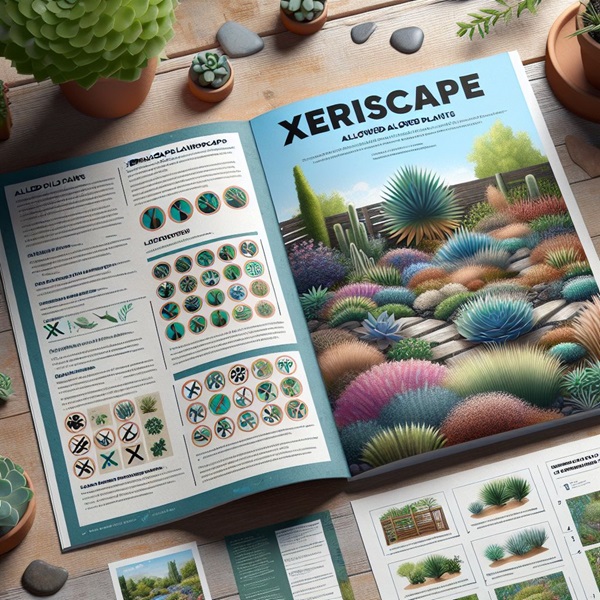
Article-at-a-Glance
- Agave is ideal for
– it thrives in arid climates, making it an eco-friendly gardening choice. - Selecting the right agave species is crucial for successful growth and landscape aesthetics.
- Soil preparation is key, with well-draining soil being a top priority for agave health.
- Watering needs are minimal, highlighting the efficiency of agave in xeriscapes.
- Design considerations include plant placement and pairing with complementary species for a stunning visual impact.
Thriving with Agave: A Low-Water Gardening Revolution
Let’s dive into the world of xeriscaping with agave, where sustainability meets style. Xeriscaping isn’t just about reducing water usage—it’s about creating a vibrant, eco-friendly garden that resonates with the beauty of nature’s resilience. Agave plants are the stars of this show, with their striking forms and drought-tolerant nature.
Eco-Friendly Benefits of Agave Landscaping
Why agave? These plants are a powerhouse when it comes to sustainable gardening. They require significantly less water than traditional lawns, which means they’re not only kinder to the environment but also to your water bill. Because they are adapted to survive in arid conditions, they are perfect for areas where water conservation is a priority.
From Arid to Abundant: Agave’s Adaptability
Agave plants originate from desert regions, but their adaptability is nothing short of remarkable. Whether you live in the sun-drenched Southwest or in areas with cooler climates, agaves can adjust with the right care. This adaptability makes them ideal candidates for a xeriscape garden.
Planting Agave
When it comes to planting agave, a little foresight goes a long way. The first step is choosing the right variety. With over 200 species, there’s an agave for every landscape. Some are small and perfect for borders, while others can grow to be large and sculptural.
Choosing the Right Agave Variety
Most importantly, consider your climate and the size of the space when selecting your agave. For example, Agave tequilana, also known as Blue Agave, is a popular choice that thrives in hot climates and offers a striking blue hue to the garden. On the other hand, Agave parryi, with its compact form and tolerance for colder temperatures, might be a better fit for less sweltering environments.
Soil Preparation for Agave Success
Agaves are not fussy about soil, as long as it drains well. Heavy, water-logged soils spell disaster for these desert dwellers. To prepare the perfect bed for your agave, mix in sand or gravel with your native soil to improve drainage. If you’re working with clay soil, consider raised beds or containers to keep those roots dry.
Caring for Your Agave Garden
Once your agave is in the ground, the hard work is mostly done. These plants are incredibly low-maintenance, but there are a couple of key points to keep in mind to ensure your agave garden thrives.
Watering Wisely: Agave’s Thirst Quenched
Agaves have evolved to store water in their leaves, which means they can go long periods without a drink. In the growing season, deep, infrequent watering helps develop strong roots. But be cautious—overwatering is the quickest way to harm your agave.
Basking in the Sun: Agave’s Light Preferences
Agaves love the sun. Full sunlight encourages healthy growth and intensifies the colors of the leaves. If your garden gets a lot of shade, don’t worry—some agave species can tolerate lower light levels, though they won’t be as vibrant as their sunbathed counterparts.
Designing with Agave
Designing a garden with agave plants is akin to painting a landscape with living sculptures. Their bold forms create visual interest and a sense of structure. But beyond their beauty, they serve a practical purpose, anchoring the soil and reducing erosion.
Create a Focal Point: Strategic Placement
Agave plants can be used as dramatic focal points in your garden. Place larger agave species like Agave americana or Agave ovatifolia in areas where they can stand out and be admired from multiple angles. Smaller varieties can line walkways or nestle into rock gardens, offering a surprise of texture and form.
Complements and Contrasts: Agave’s Design Partners
Besides that, consider the companions for your agave. Pair them with other drought-tolerant plants like
Maximizing Your Agave’s Potential
Agave plants are not just easy on the eyes; they’re also survivors, thriving where other plants might falter. To truly maximize their potential, it’s important to understand their growth cycles and how to care for them over the years.
Longevity and Bloom Cycles
Some agave plants can live for decades, and they end their life cycle with a spectacular bloom. The towering flower stalks can reach up to several feet in height, drawing in pollinators and leaving a lasting impression. After blooming, the plant will die, but often, it leaves behind pups, or offsets, which can be replanted to continue the legacy.
- Agave americana, commonly known as the Century Plant, blooms after 10-30 years.
- Agave tequilana, the Blue Agave, has a shorter life span and can bloom within 5-10 years.
- Smaller species like Agave parviflora may bloom more frequently, every few years.
Therefore, by understanding these cycles, you can plan for a garden that’s always lively and evolving.
Cost-Effective Gardening with Agave
Agave xeriscaping is not just sustainable, it’s also cost-effective. These plants require little to no fertilizer, minimal water, and are generally free from pests and diseases. By investing in agaves, you’re investing in a garden that will stand the test of time with minimal upkeep costs.
Regional Adaptability
Agaves are incredibly versatile and can be found thriving across various regions of the United States. However, they are particularly well-suited to the Southwest due to the hot and dry climate that mimics their native desert habitats.
Agave Across America: Best States for Growth
While agaves are synonymous with the Southwest, they can also flourish in other regions with some care and protection from extreme cold or moisture. States like
- Arizona and New Mexico: Native habitat for many agave species, offering ideal growing conditions.
- California: Coastal regions provide a moderate climate suitable for many agave varieties.
- Texas: Offers diverse climates where agaves can be used in both desert-like and more humid landscapes.
By choosing species that are well-suited to your local climate and soil conditions, you can ensure the success of your agave garden.

Expanding Your Horizons
Agave plants are just the beginning. There are numerous other plants that can add texture, color, and contrast to your xeriscape, creating a diverse and resilient garden ecosystem.
Similar Plants for Texture and Contrast
For a harmonious xeriscape, consider incorporating plants like yucca,
Complementary Plant List for Agave
Here are some plants that pair beautifully with agave:
- Yucca: Its spiky leaves create a dramatic contrast with agave’s rosette form.
- Sedum: Offers a groundcover option that brings a different scale to the landscape.
- Sempervivum: Also known as ‘hens and chicks’, provides a textural counterpoint.
- Lavender: Adds a soft, aromatic touch to the bold agave.
Incorporating Accessories
Your xeriscape doesn’t have to be just about the plants. Adding accessories can enhance the beauty of your agave garden and reflect your personal style.
Selecting Enhancements: Pebbles to Statues
Consider using pebbles, boulders, or even artistic statues to add interest and depth to your garden. These elements can highlight the architectural nature of agave plants and help define different areas within your landscape.
Remember, the key is to choose accessories that complement the natural beauty of your plants without overshadowing them.
Nature’s Interaction: The Wildlife Connection
Xeriscapes are not only beneficial for water conservation but also for supporting local wildlife. Agave plants can be a hub of activity for pollinators and birds, providing both food and shelter.
Rating Agave for Butterfly and Bird Attraction
Agaves are especially known for attracting hummingbirds with their large, nectar-rich flowers. They also serve as host plants for butterflies like the Yucca Giant-Skipper. Creating a xeriscape with agave not only saves water but also contributes to the local ecosystem.
Agave Edibility and Usage
Agave isn’t just a feast for the eyes; it can also be a literal feast! While not all agave species are edible, those that are have been used for centuries in cooking and beverage production. The most famous byproduct of agave is tequila, made from the fermented sap of the Agave tequilana, commonly known as the Blue Agave. Agave nectar, a sweetener, is another popular product derived from various agave species.
Savoring Agave: Not Just a Landscape Showpiece
For those with culinary aspirations, growing edible agave varieties can add a new dimension to your garden. Imagine harvesting your own agave nectar to sweeten your morning tea or experimenting with agave leaves in traditional Mexican recipes. It’s a sustainable and rewarding way to enjoy your garden’s bounty.
Agave’s Overall Xeriscape Rating
When it comes to xeriscaping, agave is a top contender. Its low water needs, striking appearance, and ease of care make it an ideal choice for water-wise gardeners. Agaves are not just surviving in xeriscapes; they’re thriving, setting the standard for other drought-tolerant plants.
Evaluating Agave as a Cornerstone of Xeriscaping
Agave plants earn a high xeriscape rating for their minimal water requirements and their ability to withstand harsh, dry conditions. They are the embodiment of sustainability in the garden, offering both aesthetic appeal and environmental benefits.
Agave Varieties:
| Agave Species | Soil Requirements | Water Needs |
|---|---|---|
| Agave tequilana (Blue Agave) | Well-draining, sandy or loamy soil 1 2 | Infrequent, deep watering 1 3 |
| Agave victoria-reginae (Queen Victoria Agave) | Gritty, low organic matter soil 1 2 | Drought-tolerant, minimal watering 1 2 |
| Agave americana (Century Plant) | Amended clay soils with added compost or gypsum 1 2 | Moderate watering during growing season 1 3 |
| Agave bracteosa (Squid Agave) | Fast-draining, rocky or sandy soil 2 4 | Tolerates some moisture but prefers drier conditions 2 4 |
| Agave ovatifolia (Whale’s Tongue Agave) | Well-draining, sandy or gravelly soil 2 4 | Drought-resistant, infrequent watering 2 4 |

FAQ: Getting to the Root of Agave Xeriscaping
Got questions about starting your agave garden? Let’s dig into some common inquiries to ensure your xeriscaping success.
How do I start an agave garden in a dry climate?
Starting an agave garden in a dry climate is straightforward. First, select agave species that are known to thrive in arid conditions. Prepare a site with well-draining soil, and consider adding gravel or sand to improve drainage if necessary. Plant your agaves with plenty of space to grow, and water them deeply but infrequently to encourage strong root development.
Are all agave plants the same when it comes to water needs?
While all agave plants are drought-tolerant, their water needs can vary. Some species may require occasional watering during extremely dry periods, while others can go longer without water. Always research the specific needs of your chosen agave species.
How often should I water my agave plants?
Watering frequency for agave plants should be minimal. During the summer, a deep watering every two to three weeks is typically sufficient. In cooler months, you can reduce watering even further. The key is to let the soil dry out completely between waterings to prevent root rot.
What other plants pair well with agave?
Agave plants pair well with other drought-tolerant species such as sedum, salvia, and ornamental grasses. These companions not only share similar water needs but also offer contrasting shapes and textures for a visually appealing xeriscape.
Can I include decorative items in my xeriscape with agave plants?
Absolutely! Incorporating decorative items like rocks, sculptures, or mulch can enhance the visual appeal of your agave xeriscape. Just be sure to choose items that complement the natural beauty of your plants and don’t impede their growth or access to sunlight.




Leave a Reply